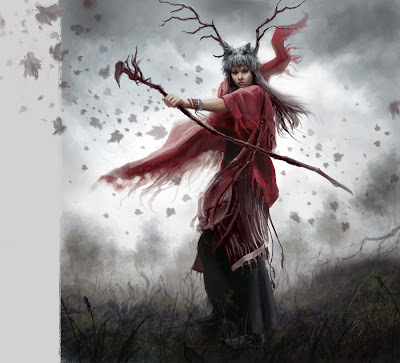Since my previous post for Six Sentence Sunday was a snippet involving a shaman character, it seemed appropriate to discuss shamanism in my Magical Monday feature this week as I continue my exploration of classical witchcraft/spiritualism.
Shamanism embraces the belief that shamans are messengers between the human world and the spirit worlds.
Shamanism is a 'calling'. Individuals who are 'called' often experience an illness over a prolonged period of time, as a sign. The common belief is that the shaman must become sick to understand sickness of others. He/she crosses over to the underworld to bring back vital information for mending sickness and community concerns. When the shaman overcomes his own sickness he will hold the cure to heal all that suffer. He/she then bears the mark of the wounded healer.
The practice of a shaman is solitary. Their work begins with a vision quest to locate an animal familiar, called a power animal or totem spirit. Then, a shaman will seek a trance-like state, opening their mind to altered perceptions. Various methods are used to reach that semi-consciousness state: meditation/solitude; use of hallucinogenic drugs; rhythmic drumming; chanting; rattling; dancing. Plant toxins used to alter consciousness can pose life-threatening dangers. When the trance is attained, the shaman will call to his/her power animal, which energizes and enables passage into the other dimension. Power animals guide and protect during the journeys through that world.
Once there, a shaman will carry out a mission, battling demons or requesting spiritual assistance. A basic premise is that by alleviating traumas affecting the soul, a person’s physical body will be restored to balance and wholeness. Shamans treat ailments/illness by mending the soul. The shaman also enters supernatural realms to find solutions to problems of the community. For these reasons, shamans are often hold high social positions in their communities.
This video shows a trance-inducing graphic and measured rhythmic drumming, both examples of techniques used by shamans to alter their mental states. Since most blog readers are wired on their morning caffeine, the effects may be lessened!
Next week, I’ll explore a few different types of shamanism from around the world.
Art reference: anotherwanderer
Video reference: Ryan Taylor Anderson
Don't forget--contest ends March 31st to win printed copies of my illustration, an intimate beach scene with my mermaid and merman couple from Tears on a Tranquil Lake. See my website, the contest page, for details. http://www.MarshaAMoore.com
Video reference: Ryan Taylor Anderson
Don't forget--contest ends March 31st to win printed copies of my illustration, an intimate beach scene with my mermaid and merman couple from Tears on a Tranquil Lake. See my website, the contest page, for details. http://www.MarshaAMoore.com
































6 comments:
Marsha,
Well done. I do take exception to shamanism being called witchcraft. Those shaman and shamakas I have known would not appreciate that label.
Thank you for pointing that out to me. I was referring to a reference book, using their collective term for all types of ancient or "low" magic--classical witchcraft. The line between spiritualism and witchcraft/magic can be very vague, and often subject to varied opinions. I do appreciate this and mean no offense. Labels are tricky things.
I'm a firm believer in shamanism. I met a shaman a few weeks ago - and was quite close with a very powerful Hopi shaman many years ago. He's since passed away, but his abilities were uncanny - chill-inducing!
What amazing experiences. Thanks for sharing, Julia.
Hey Marsha, I am a shaman and it really doesn't have much if anything to do with witchcraft. A shaman walks between the many layered worlds and works to achieve balance and healing on all planes of existence. I am a Faery Shaman Pathmaster and as such do not use any mind altering drugs, chemical or natural. THe altered state of consiousness is acheived by measured breath and may be accompanied by drumming, drum stirring or singing bowls. The most important belief for a Faery Shaman is Do no harm. Secondly, I do not use my position to influence events or people for my own or anyone else's benefit.
Love that you are exploring these things on your blog and look forward to seeing more of your work in the future.
Nancy
I really must spend more time with my dear editor! Thank you, Nancy, for giving me some additional insight.
Labels and names for categorizing are often misinterpreted, especially those involving spiritual study. Being a Tibetan Buddhist, many of those spiritual practices are often viewed by outsiders as occult, dark magic. The first that comes to mind is the concept of rainbow bodies, where the body of a deceased Buddhist teacher does actually shrink to the size of an infant. There is much that is not explainable in our world, and accepting that is key. Applying terms to categorize such events (magic, witchcraft, spiritual study, paganism, or occultism) is really only a poor attempt to describe something very elusive.
Post a Comment